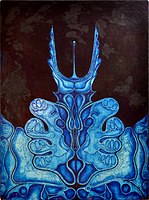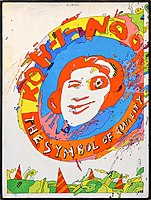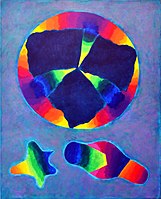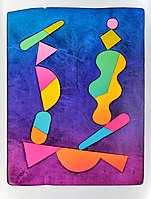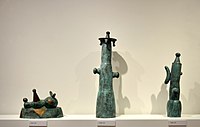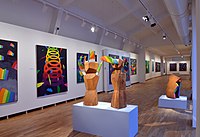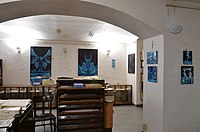|
Aleš Lamr
Aleš Lamr (12 June 1943 – 16 February 2024) was a Czech visual artist. He presented himself as a painter, printmaker, author of murals and ceramic reliefs, sculptor and ceramist. LifeAleš Lamr was born the eldest son of three children in a family of stove-builders and ceramists, settled in Litovel over several generations. His sisters are also artists (Eva Bergeå Lamrová,[1][failed verification] * 1946, painter and ceramicist, Blanka,[2] Aleš * 1949, photographer and ceramicist). The ceramic workshop, with which many important Moravian artists collaborated, is still active today.[3] In 1974, a family exhibition of ceramics held in Ústí nad Orlicí, was attended by ten members of the Lamr family. Lamr received his primary education in Litovel (1948–1957) and his further direction was influenced by the Litovel painter and teacher Karel Homola, a pupil of Max Švabinský. In 1957, Aleš Lamr, as the son of a tradesman, was sent to an apprenticeship at the Ostrava-Karviná Mines. In Ostrava, he attended a primary art school run by the Litovel artists Zdeněk Kučera (1935–2016) and Jaroslav Rusek (1932–2016).[citation needed] From 1960 to 1964, he studied at the Secondary School of Arts and Crafts, Department of Spatial Design in Brno, under prof. arch. J.A. Šalek. There he gained experience in the field of scenography and mastered artistic techniques ranging from painting and printmaking to working with wood, glass, metal, plastic and paper. He applied unsuccessfully for admission to the sculpture studio at the Academy of Fine Arts in Prague. In 1964–1966, he completed his basic military service, where he first joined the Vít Nejedlý Army Art Ensemble as a Mime artist and later was assigned as an artist in publicity and in a mobile print shop. At the height of the New Wave of Czech cinema (1966–1968), he worked as an assistant director at the Czechoslovak State Film at Barrandov (directors Ivo Novák, Ladislav Helge, Josef Mach, among others). At that time he shared a studio in Štěpánská Street with photographer Helena Pospíšilová-Wilsonová and belonged to the circle of artists of the Křižovnická School.[citation needed] From 1968 he was registered as a candidate of the then Union of Czech Visual Artists and could earn a living as a freelance artist (he was not admitted as a full member until 1989). He first exhibited independently in 1968 at the private Small Gallery in Žižkov (defunct since 1970) and in 1970 at the Young Gallery in Mánes. In 1969 he travelled for the first time to Stockholm, where his sister was married, and visited the galleries there. He was influenced by Pablo Picasso's monumental sculptures in Moderna Museet Park. He exhibited at the important national show of contemporary painting, Painting 69 in Brno. In 1969–1970, he received a scholarship from the Union of Czech Visual Artists and produced several film posters.[citation needed] In 1971 he moved to Malá Strana and the following year he married textile artist Blanka Grebeňová. His son Řehoř (born 1973) is an entrepreneur, his sons Hanuš (born 1976) and Jan (born 1983) are artists.[4] In 1978 he acquired a studio in Malá Strana and began to work on lithography in the lithography workshop of Jan Tůma. Later he also collaborated with lithographers M. Řehák, J. Lípa and J. Kejklíř.[citation needed] In 1975 he travelled to France and in 1979, in connection with his first foreign exhibition, to the United States, where he met Meda Mládková and visited galleries in New York and Washington, D.C.. In the 1980s he travelled to France, the Netherlands and Germany. During the 1980s, he participated in various unofficial projects (Malostranské dvorky, Krabičky - Jazz Section, the private Kruh Gallery in Kostelec nad Černými lesy). Beginning in 1982 he collaborated as a designer with the Husa na provázku theatre in Brno (theatre events Mr. Třesky and Mr. Plesky, 1987, with Jaroslav Kořán, 20 years of Husa na provázku theatre).[citation needed] At the time of the fall of the communist regime in November 1989, he created two posters (New Life, Happened on National Street). In the early 1990s, at the request of Václav Havel, he created several murals in the presidential office and in 1995 in his private villa. He collaborated with a number of architects (E. Zavadil, M. Rajniš, B. Dudař, J. Lábus) and had dozens of realizations in mural painting and ceramics (together with M. Neubert). In 1992, he exhibited at the Seville Expo '92 (the Burning Bush exhibition, originally in the Emmaus Monastery) and in 1993, together with arch. P. Fuchs participated in the artistic design of the pavilion for Expo '93 in Taejŏn, South Korea.[citation needed] In 2002 he moved to a new studio in Hostivař.[citation needed] Lamr was a member of the art department of the Umělecká beseda and between 1991 and 2013 he was a member of the Hollar Society. He lived and worked in Prague and Petrovičky.[citation needed] Lamr died on 16 February 2024, at the age of 80.[5] Awards
WorkPaintings, drawings and printsAleš Lamr was one of the few essential colourists on the Czech art scene and his paintings are unmistakable in their style. They are characterized by flat drawings and marks abstracted from reality, filled with contrasting colours that look like a playful mosaic.[7] Lamr's drawings are integrally composed in both surface and detail and often contain urgent messages, interpreted in a surprising artistic cipher.[8] In his youth, he was influenced by the environment of the family's ceramics workshop but also by the colourful exotic butterflies in the collection of his grandfather, who had made a trip to South America in the 1930s. While studying at high school, he visited exhibitions of Bohumil Kubišta (1960) and, influenced by his paintings, created the expressive Self-Portrait (1964). His early paintings, which the artist described as "Indian Baroque",[9] are characterized by totemic shapes, personifying the mysterious myths of ancient exotic civilizations. The magical ornamental fantasy of Lamr's paintings springs from somewhere in the darkness of human cultural history, and the painter co-created it with his imagination, as if it were not only an artistic but also a spiritual drug.[10] These ornamental symbols from 1966 to 1967, which are often composed symmetrically to a central axis, have the character of hallucinatory revelations.[11] The paintings are darkly transparent and mostly monochromatic blue, and are strikingly at odds with Lamr's other work, but the prosaic reason was the lack of funds, which then sufficed for only one painter's paint.
During Lamr's military service, when he worked as an artist and was tasked with, among other things, designing posters, Lamr's artistic style changed. The mid-1960s in the Czech milieu are characterized by a growing polemic with abstraction and the actualization of various forms of figuration. At the end of the 1960s, Aleš Lamr adopted and interpreted the playful colourfulness of Pop art in his own way and picked up on the impulses of narrative figuration in an original way (exhibition at the Václav Špála Gallery, 1966, curated by Gérard Gassiot-Talabot), but he was also influenced by the legacy of domestic mannerism. He created a world of fancifully metaphorical narrative, which was based on the ordinary realities of contemporary life.[7] From the early 1970s, Lamr's artistic style was characterized by loose outline drawings of objects and figures, and surfaces filled with varied but harmoniously softened tones of acrylic paint that create a dynamic mosaic of shapes. The painter's training in spatial art is evident in his inventive work with the backdrops of the spatial plans of the painting, in which vivid movement takes place. The distinction between the shape of a concrete object derived from reality and a wholly abstract sign disappears, and the silhouette of the object and its internal structure merge seamlessly with the surrounding space through patches of identical colours.[12] If his paintings from the 1970s can be loosely classified with the "Czech Grotesque" and "New Figuration", they should also be placed in the context of the hilariously artistic grotesque of Californian "funk-art"[13] or the playfully critical naïveté of the "Imaginists" from the Chicago area.[14] Compared to American Pop art, with its flat graphicism and reportage-like matter-of-factness, the European "New Figuration" is characterized by a looser play with pictorial motifs.[note 1] Lamr combined this mannered dynamic shape metaphor with the narrative style he developed in the following years.[15]
The "New Figuration" movement and its specific existentially burdened offshoot, called the "Czech Grotesque", developed from the mid-1960s and continued through the period of normalization until the 1980s. The painters Jiří Načeradský, Jiří Sopko, Václav Mergl, Rudolf Němec, Zbyšek Sion, and the sculptors Karel Nepraš, Bohumil Zemánek, Karel Pauzer, and Hana Purkrábková were among its members. Some of Aleš Lamr's paintings from the 1970s have the character of an artistic gag. According to Václav Havel, a gag can be regarded as a specific case of the embellishment of the initial situation, consisting in its overturning and exposing the absurdity and absurdity, thus creating the actual meaning core of the gag.[16] The playfully grotesque form of Lamr's ""New Figuration"", the spontaneous play with shapes and the joy of free white space continued the liberating optimism of the late 1960s and lightened the gloomy atmosphere of the occupation despair of the normalization years.[10] In the 1980s, when society's general weariness with the atmosphere of normalization was at its peak, a dark colour appeared in Lamre's paintings, from which a rainbow, star, spiral or cross emerged as colour symbols related to the sky rather than the earth. A serious element of deep personal faith comes into play, and this respect for spiritual values is associated with a heightened level of abstraction and a move towards aggregate symbolic forms with timeless validity.[17][10]
Lamr's painting after 1989 moved towards generalization and de-psychologization of content. Increasingly larger formats display the grace of geometric and anarchically abstract configurations, in which he seemed willing to show the viewer all the shape types that determine the synthetic nature of the world. Lamr's motto for the exhibition at the Prague Castle Ball Game Hall (2003), "The Spirit blows where it wills", taken from the Bible, fully expresses the lightness and playful imagination of his work after 2000. It is dominated by abstraction and the spontaneous gesture of painting, expressed by throwing paint onto the canvas, symbolizes the dynamics of the modern world and the liberating moment of the elemental joy of life.[7]
Lamr also used colour dripping, using bright acrylic paints and composing collaged paintings from their fragments. In a series of abstract paintings entitled Maranatha (2015),[note 2] he opened up the pictorial space to randomness, sometimes with the intention of juxtaposing disparate abstract expressions. The result is a playfully optimistic game in which the painter sees a way to understand the creative genius of creation[note 3] and Creation myth.[18] The titles of the abstract paintings painted in acrylic loosely refer to specific sources of inspiration (Red Hair, 2016, Pink Promenade, 2016, Rasputin, 2016), but in fact express the need to capture the essence and meaning of the paint itself.[19] After the previous series, Aleš Lamr gradually returned to figuration (New Women, 2016). He used the technique of collage, cutting out silhouettes of female bodies from scraps of flats of coloured acrylic paint, combining them in playfully erotic and dynamic compositions of female athletes or dancers. Some paintings paraphrase classical themes (Master and Margaret, 2013, Leda and the Swan, 2014, Apollo and Marsyas, 2015). Lamr activates some aspects of his early work and reflects on the growing feminine element of the contemporary world, which, in addition to being poignantly engaging, invites deeper reflection.[20]
Lithography
Sculpture and ceramicsAfter graduating from art school, Aleš Lamr felt that he had mastered drawing and painting well and was more attracted to artistic expression in spatial form. He failed the entrance exams for sculpture, yet throughout his life, in parallel with painting, he has been creating sculptures which are actually three-dimensional painting objects. From the classical figuration of the mid-1960s, when he worked in stone and bronze, he moved on to loose, colourfully polychromed and grotesque figures in wood, which are close in character to the life-celebrating and playful sculptural metaphors of Niki de Saint Phalle. His sculptures are mostly carved from a block of wood and supplemented with various protrusions (Striped Elephant, 1973) or assembled from flat parts (Jester and Queen, 1985). The series Heads (polychrome wood, 2015) forms a counterpart to the abstract paintings of the same period and is characterized by its playfulness and spontaneous color. The sculptor also works with ceramics and porcelain, decorated with coloured glazes. Some smaller porcelain objects were also cast in bronze. The inclination towards the sculptural form follows Lamr's outdoor actions from the 1970s, and many of the sculptures have found application in architecture.[8]
As a three-dimensional counterpart to his paintings, he also creates spatial installations made of steel wire. He uses bent metal reinforcement obtained from the recycling of reinforced concrete, which he polychromes. Together with Jan Beran's artistic blacksmith shop, he has made polychromed welded metal sculptures of musicians for Průhonice. Realizations (selection)
Illustrations
Representation in collections
Films
Author´s exhibitions (selection)
References
Notes
Sources
External linksWikimedia Commons has media related to Aleš Lamr. |
||||||||||||||
Portal di Ensiklopedia Dunia



